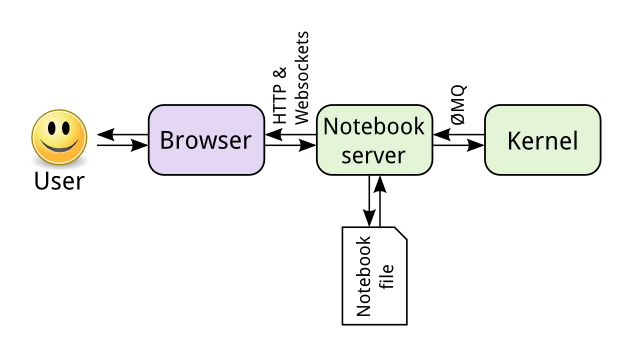Intro to Jupyter
And its friends
J. Horacsek
What is Jupyter?
Have you used Maple or Mathematica?
- Jupyter is a notebook front end for multiple different environments
- Started as IPython, but evolved into something much bigger and much more general
- Julia, Python and R
- But many more languages are supported (see the list)
- Today, we'll only focus on Python
What is Jupyter?
Jupyter is a notebook web front end for multiple different environments

[source]
How do I use it?
There are multiple ways of accessing Jupyter
- http://ucalgary.syzygy.ca/: A remote Jupyter server with Python 2,3, Julia, and R kernels installed, you have access to this via your uCalgary account
- Anaconda: A distribution of Python that focuses on scientific computing. 'conda install jupyter' at the command line
- pip install jupyter (not recommended)
See the install guide for local setups
We'll be using syzygy
Included Worksheets
I sent out a small set of worksheets that will form the basis for the rest of this presentation, the first five can run on Syzygy
- 01_intro: a short intro to how Jupyter notebooks work, and a brief primer on Python
- 02_plots: plotting with matplotlib in notebooks
- 03_interactive_widgets: creating interactive notebooks
- 04_cell_display: creating rich output
- 05_an_esoteric_example: a more sophisticated example of what can be done in a notebook
Included Worksheets
The last two run on my local machine (they require libraries not available on Syzygy)
- 06_vtk_bindings: A simple example showing how to render images from VTK in a notebook
- 07_neural_nets: An example using Keras showing how create and train neural networks
If you want to follow along with those, you'll need a few libraries. At the terminal, install
conda install -c conda-forge keras=2.0.2
conda install theano vtk pydot graphvizIncluded Worksheets
The goal is not to give you a deep understanding of any one topic, but rather to show you what can be done, then provide resources for further exploration.
Intro to Jupyter/Python
- 01_intro: a short intro to how Jupyter notebooks work, and a brief primer on Python
- 02_plots: plotting with matplotlib in notebooks
- 03_interactive_widgets: creating interactive notebooks
- 04_cell_display: creating rich output
- 05_an_esoteric_example: a more sophisticated example of what can be done in a notebook
- 06_vtk_bindings: A simple example showing how to render images from VTK in a notebook
- 07_neural_nets: An example using Keras showing how create and train neural networks
Resources
There are a couple of key core libraries in the Python scientific computing scene
- NumPy: NumPy is the fundamental package for scientific computing with Python. It's the basis for numerical computing in Python
- SciPy: Numerical routines, solving ODEs, etc... Higher level functions (documentation)
- matplotlib: Plotting in Python
- pandas: an open source library providing high-performance, easy-to-use data structures and data analysis tools
- Jupyter
Resources
There are also many more interesting libraries/environments available for Python
- scikit-learn: Classification, clustering, regression, etc...
- keras: a high-level neural networks API
- tensorflow/Theano: Support libraries for deep learning
- SageMath: An open source alternative to Mathematica, Maple, etc... More of an environment than a single library
Thanks!
Questions, comments, concerns, suggestions?
Intro to Jupyter
By Joshua Horacsek
Intro to Jupyter
- 1,070



